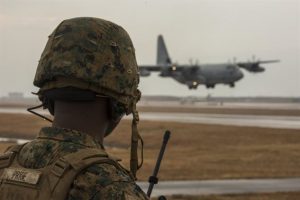2017-01-14 According to a story published on December 23, 2016 by Cpl. Aaron Henson, Marines based at Iwakuni, Japan recently exercised their capabilities to employ expeditionary runways.
U.S. Marines with Marine Air Control Squadron 4 Detachment Bravo, Marine Air Traffic Control Mobile Team, conducted aircraft landing zone training at Marine Corps Air Station Iwakuni, Japan, Dec. 21, 2016.
The training allows the Marine Air Traffic Control Mobile Team, or MMT, to gain experience, practice constructing an expeditionary airfield, and complete training and readiness requirements.
“MMT usually consists of six to eight Marines set to operate in a 72 hour environment by themselves . . . without support,” said U.S. Marine Corps Cpl. Chris Swogger, an air traffic control Marine with MACS-4 Detachment Bravo. “If we were in combat we would be able to establish an expeditionary runway. We go out and set up these runways, land and refuel aircraft, which allows us to further push into the country without having to take over airfields or build permanent structures.”

A MMT comprises of a base, pace, chase, reference, navigation aid and communication technician who establish a 60-foot wide and 3,000-foot long runway in remote locations during combat scenarios, medical evacuations or for humanitarian aid.
“The base Marine establishes the front end of the runway and are the ones in control talking to the aircraft,” said Swogger. “The pace Marine runs down the 3,000-foot landing zone and every 500 feet drops off a panel marking. The chase Marine follows the pace and sets up the left side of the runway. And the reference point Marine runs all the way down to the 3,000-foot marker and acts as the in-between for the base and pace, and allows base to line up the runways with the reference point at the far end.”
The MMT Marines conduct this training every three to six months to refine the Marines’ skills, keeping them ready for expeditionary operations while in a garrison environment.
Marine Aerial Refueler Transport Squadron 152 assisted MACS-4 Detachment Bravo while also completing their training and readiness requirements.
“MMT Marines are extremely important to our aircraft landing zone operations,” said U.S. Marine Corps Capt. Jeffrey Simonson, a KC-130J pilot with VMGR-152. “They are able to set up the strip to resemble what would be seen in a real world scenario. The runway we use in Okinawa does not provide realistic training. The landing strip here in Iwakuni is much smaller, providing challenging and realistic training for the squadron. Each pilot has to conduct this training a minimum of once a year.”
U.S. Marine Corps Staff Sgt. George Price, an MMT instructor with MACS-4 Detachment Bravo, assisted directing aircraft to the runway from the ground.
MMT instructors are trained by Marine Aviation Weapons and Tactics Squadron 1 at Marine Corps Air Station Yuma, Arizona, over a six-week period.
“To be an instructor we have to go through MAWTS-1 and participate in a lot of the live-flying training with every type of aircraft the Marine Corps has,” said 1st Lt. Jeremy Graves, air traffic control officer with MACS-4 Detachment Bravo. “We learn our pace counts, how to set up an airfield, controlling aircraft in an expeditionary environment, and we work with all of Weapons and Tactics Instructor Course. It is a big event and a lot of training goes into it.”
Graves said the Marines will be conducting aircraft landing zone training quarterly and did well for their first time conducting this training on the air station.

